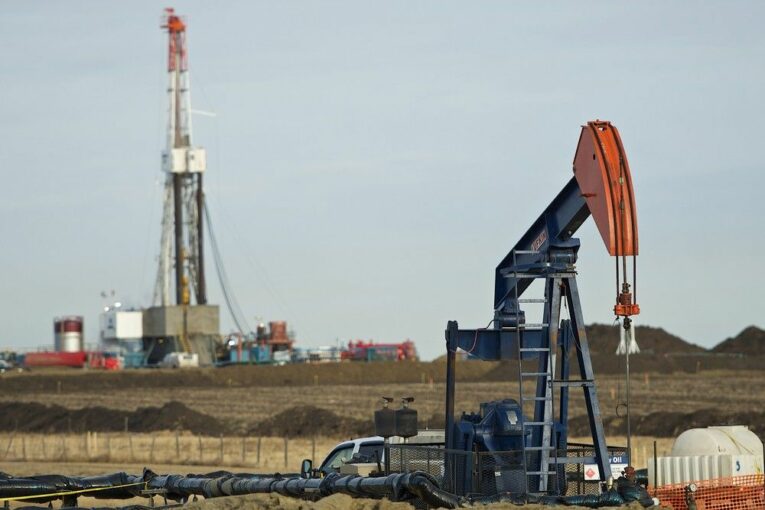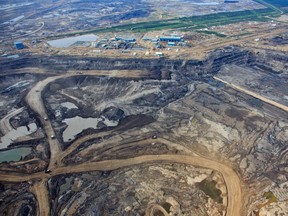
The short-term outlook for Canadian oil and gas is improving, although the mid-term forecast is a lot like summer weather on the Prairies this year — hazy and uncertain.
As industry leaders gathered at the annual Global Energy Show in Calgary on Wednesday, a new report by industry group Enserva indicates oil and gas drilling in Canada will increase by 12 per cent this year, with 6,180 wells expected to be completed across the country.
Meanwhile, a new study by the International Energy Agency examining oil markets indicates Canadian crude production is forecast to rise, albeit slowly, to top six million barrels per day (bpd) by 2028.
That’s up about 400,000 bpd from last year’s output.
The Paris-based agency projects global oil demand will grow by 2.4 million bpd this year and hit a record 105.7 million barrels per day by 2028. However, annual demand will only increase by 400,000 bpd in 2028, “putting a peak in demand in sight,” the IEA noted.
“It does very clearly state we need more oil. If demand continues to grow, you need more supply,” said Kevin Birn, a vice-president with S&P Global Commodity Insights in Calgary.
“In the world we’re in, we have to ask ourselves: Where is that supply going to come from?”
For the Canadian sector, the answer is straightforward.
The country is already the world’s fourth-largest oil producer and contains the third-largest crude reserves, with the ability to add more volumes.
In Alberta, output has been rising in recent years with incremental additions and smaller expansions, but major greenfield oilsands developments have not moved ahead due to turbulent commodity prices, uncertain regulatory policies, and pipeline constraints last decade.
And then, there are also ongoing pressures on the industry to reduce greenhouse gas emissions.
At the Global Energy Show, MEG Energy CEO Derek Evans noted, “We have a massive amount of energy in this province and we have massive amounts of decarbonization potential.”
The intersection of globalization and decarbonization presents new opportunities for Canada.
“We are not creating barrels in the hope that somebody is going to buy them. This is a demand-driven business, not a growth-driven business,” Evans said in an interview.
“I continue to see increasing demand. That says to me, OK if you look at the mix of oil production that we should expect to see going forward, the oilsands need to be a big part of that — decarbonized oilsands.”
The oil and gas sector generated about 28 per cent of all emissions in Canada in 2021.
MEG is a member of the Pathways Alliance, a group of the country’s largest oilsands producers working together to reach the target of net-zero emissions by 2050.
Recommended from Editorial
-

Smith, executives bring energy transition to centre stage at Global Energy Show
-

Alberta wildfires increase again, threatening air quality and energy production
-

Canadian oil sitting pretty as U.S. shale shows signs of fatigue: BMO top energy banker
-

Varcoe: Oilsands giants warn Canada falling behind U.S. on carbon capture incentives
Enserva released its state of the industry report indicating energy demand is growing, capital spending by producers in Canada is climbing and commodity prices remain relatively strong.
Among the provinces, Alberta is expected to see the greatest bump in investment, with more money being spent in the Montney, Clearwater and Duvernay plays.
For the oilfield services sector, employment will conservatively jump by up to 4,000 jobs this year.
“Although our drilling numbers aren’t going up significantly, we are drilling more than we did last year,” said Enserva CEO Gurpreet Lail.
“It’s looking strong to take us into 2024.”
With the immediate outlook for oil markets appearing to be bumpy, many analysts expect stronger prices in the second half of the year as demand in Asia — led by China — continues to rebound.
West Texas Intermediate (WTI) crude prices, which were hovering above US$80 a barrel in April, closed Wednesday at $68.27. Benchmark U.S. natural gas prices closed at $2.34 per million British thermal units.
Globally, oil consumption has bounced back and is now above pre-pandemic levels. The IEA projects demand will average 102.2 million barrels per day in 2023, up from about 100 million bpd last year.
International investment in oil and gas exploration and production is rising, expected to increase by 11 per cent this year to US$528 billion, its highest point since 2015.
The IEA forecasts that Canadian oil production, which averaged about 5.8 million bpd last year, will slowly increase in the coming years, reaching almost 6.2 million in 2028.
“Canadian production continues to recover from its 2020 slump,” the report states.
“Optimization and debottlenecking of operations at oilsands projects will add incremental barrels, but new capital projects are limited in number and scope by the scars of the pandemic, expectations of carbon tax increases and, like their U.S. counterparts, calls by investors to return cash.”

Oil for global transportation use is expected to decline after 2026 with the growth of electric vehicles. By 2028, more than one in four new cars purchased will be an EV, up from one in seven in 2022.
However, increases in petrochemical use and an expected recovery in jet fuel consumption will increase mid-term oil demand.
“The shift to a clean energy economy is picking up pace, with a peak in global oil demand in sight before the end of this decade as electric vehicles, energy efficiency and other technologies advance,” said IEA executive director Fatih Birol in a statement.
In Canada, Evans sees potential growth in LNG and oilsands production, given the large reserve base in the country.
“We don’t need to be a green island,” he added.
“We can reduce the carbon footprints on both of those products, but we should be selling those and supplying the rest of the world.”
Chris Varcoe is a Calgary Herald columnist.
You can read more of the news on source
